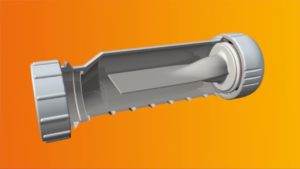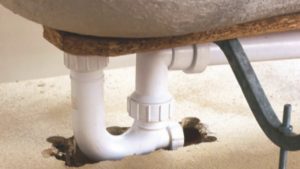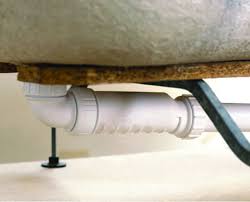Plumbing in tiny spaces can be a real challenge. Every square centimeter is precious and you don’t have a crawl space or lower floor to intrude into. If you’re putting a tub or shower into your Tiny House, one of the problems we’ve run into is that your p-trap ends up protruding down below the bottom of your floor, exposed to cold and damage. The only other alternative to this is to raise your tub/shower up higher, to lift the drain and p-trap. This isn’t ideal, because the bathroom tends to be below your loft, leaving you with little headroom! Read on to learn about a clever alternative that can save you space and hassle.
What is a p-trap anyway?
A p-trap is a plumbing device shaped like, you guessed it, a P! It’s simply a section of drain pipe that goes down and then back up again, underneath a drain. It traps a small amount of water in the pipe, which prevents sewer gases from escaping into your home. Water and waste sent down the drain flow easily through the bend but some water always remains, sealing off the waste system or black water tank from the atmosphere of your home. It’s needed under sinks and showers/tubs. Toilets have the trap built right into their design, negating the need for a trap below them.
What’s the problem?
Well, with a normal house, the p-trap is inside the building envelope, warm and snug. It can never freeze and has lots of space, as it just intrudes into the floor below it or crawl space. On a Tiny House, there’s nothing below, so the trap basically sticks out the bottom, below your trailer and insulation. In colder climates, this is an issue as it can freeze and crack the plumbing (or plug your drain!). It’s also a problem anytime the unit is unheated for a while, as even the traps under the sinks can freeze. To solve this problem, we turn to the RV industry. Recently I discovered the amazing HepvO Waterless Valve. It’s a new solution to this old problem.
Using a flexible silicon tube inside that seals out air but allows water to flow in one direction, it performs the same task without using any water and without being large and bulky like a p-trap. It can be installed horizontally, which is ideal for the small space under a tub or shower, saving you from cutting out the floor or trying to insulate the trap that protrudes below the chasis. It also allows you to keep your DWV (drain) pipes inside your building envelope as long as possible, protecting them from freezing.
Here’s what it looks like inside:

And here’s an example of using a traditional p-trap under a tub vs a Hepvo Valve:


For those of use trying to cram a lot of plumbing into a small space, it’s a clear winner. You can also use them under the kitchen sink or bathroom sink to reclaim a little bit more space and eliminate the need to drain your p-traps if leaving your home for an extended period of time. Hepvo Valves are approved for residential and RV use in the US and for RV use in Canada.

